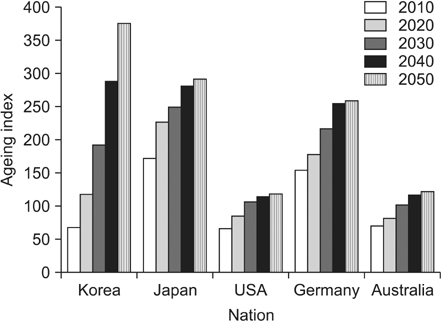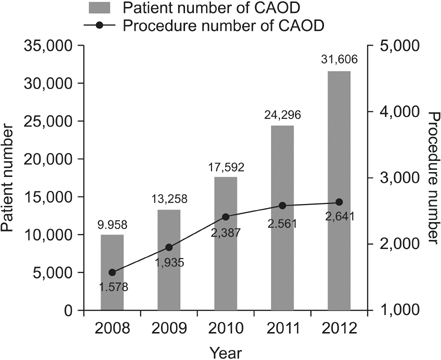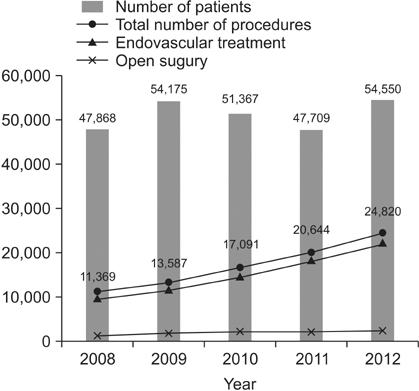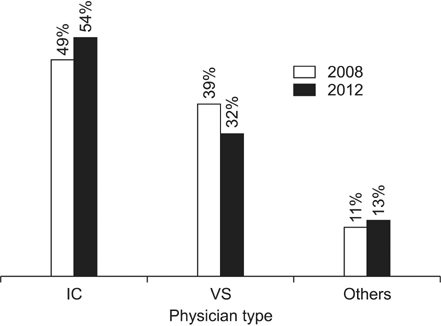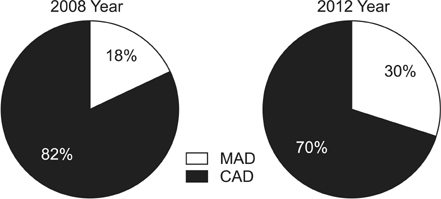Ann Surg Treat Res.
2016 Apr;90(4):218-223. 10.4174/astr.2016.90.4.218.
Current trends of major arterial diseases in Korea: based on data from the Health Insurance Review and Assessment Service
- Affiliations
-
- 1Department of Surgery, College of Medicine, The Catholic University of Korea, Seoul, Korea. wonys@catholic.ac.kr
- KMID: 2160952
- DOI: http://doi.org/10.4174/astr.2016.90.4.218
Abstract
- PURPOSE
This study aims to figure out the changes of the prevalence and management of carotid arterial occlusive diseases (CAOD), abdominal aortic diseases (AAA), and arterial diseases of the lower extremities (LAOD) in Korea over the past 5 years.
METHODS
Data were extracted from the Health Insurance Review and Assessment Service during the period from 2008 to 2012.
RESULTS
The number of patients with CAOD increased by about 30% every year. From the year 2008, the number of open surgeries (OS) and endovascular treatments (ET) increased by more than 20% during each of the first 2 years and by 10% every year for 3 years thereafter for CAOD. ET was preferred to OS and occupied 77%-79% of the total number of procedures. The number of patients with AAA increased by 11%-17% every year. ET for AAA occupied 52% of the total number of procedures in 2008 and gradually increased to 70% in 2012. The number of patients who were diagnosed with LAOD fluctuated over the five years. The total number of procedures to treat LAOD increased each year by 20%-25%. ET for LAOD constantly increased by 18%-24% each year and occupied 80%-95% of the total number of procedures.
CONCLUSION
It is evident that the incidence of vascular diseases will be increasing as our society ages, not to mention its care costs. The need for long-range plans and guidelines are urgent.
Keyword
MeSH Terms
Figure
Reference
-
1. Korean Statistical Information Service [Internet]. Daejeon: Statistics Korea;2016. 2014 Feb 17. Available from: http://kosis.kr/statisticsList/statisticsList_03List.jsp?vwcd=MT_RTITLE&parmTabld=M_03_01#subCont.2. Diehm C, Schuster A, Allenberg JR, Darius H, Haberl R, Lange S, et al. High prevalence of peripheral arterial disease and co-morbidity in 6880 primary care patients: cross-sectional study. Atherosclerosis. 2004; 172:95–105.3. Fowkes FG, Rudan D, Rudan I, Aboyans V, Denenberg JO, McDermott MM, et al. Comparison of global estimates of prevalence and risk factors for peripheral artery disease in 2000 and 2010: a systematic review and analysis. Lancet. 2013; 382:1329–1340.4. Steg PG, Greenlaw N, Tendera M, Tardif JC, Ferrari R, Al-Zaibag M, et al. Prevalence of anginal symptoms and myocardial ischemia and their effect on clinical outcomes in outpatients with stable coronary artery disease: data from the International Observational CLARIFY Registry. JAMA Intern Med. 2014; 174:1651–1659.5. Ko DT, Tu JV, Austin PC, Wijeysundera HC, Samadashvili Z, Guo H, et al. Prevalence and extent of obstructive coronary artery disease among patients undergoing elective coronary catheterization in New York State and Ontario. JAMA. 2013; 310:163–169.6. Krumholz HM, Normand SL, Wang Y. Trends in hospitalizations and outcomes for acute cardiovascular disease and stroke, 1999-2011. Circulation. 2014; 130:966–975.7. Toyoda K, Ninomiya T. Stroke and cerebrovascular diseases in patients with chronic kidney disease. Lancet Neurol. 2014; 13:823–833.8. Brown RD Jr, Broderick JP. Unruptured intracranial aneurysms: epidemiology,natural history, management options, and familial screening. Lancet Neurol. 2014; 13:393–404.9. Ciccone A, Valvassori L, Nichelatti M, Sgoifo A, Ponzio M, Sterzi R, et al. Endovascular treatment for acute ischemic stroke. N Engl J Med. 2013; 368:904–913.10. Casey RG, Richards S, O'Donohoe M. Vascular surgery of the upper limb: the first year of a new vascular service. Ir Med J. 2002; 95:104–105.11. Edwards MS, Hansen KJ, Craven TE, Cherr GS, Bleyer AJ, Burke GL, et al. Relationships between renovascular disease, blood pressure, and renal function in the elderly: a population-based study. Am J Kidney Dis. 2003; 41:990–996.12. Wilson DB, Mostafavi K, Craven TE, Ayerdi J, Edwards MS, Hansen KJ. Clinical course of mesenteric artery stenosis in elderly americans. Arch Intern Med. 2006; 166:2095–2100.13. Stoney RJ, Cunningham CG. Acute mesenteric ischemia. Surgery. 1993; 114:489–490.14. Cho WP, Park IS, Jeon YS, Kim JY, Kong T, Jung JE, et al. Vascular disease prevalence and risk factors in a screened Korean male population. Ann Vasc Surg. 2015; 29:215–221.15. Creswell J, Abelsonjan R. Medicare payments surge for stents to unblock blood vessels in limbs. New York Times [Internet]. 2015. Jan. 19. cited 2015 May 13. Available from: http://www.nytimes.com/2015/01/30/business/medicare-payments-surge-for-stents-to-unblock-blood-vessels-in-limbs.html?_r=2#.16. Society for Vascular Surgery Lower Extremity Guidelines Writing Group. Conte MS, Pomposelli FB, Clair DG, Geraghty PJ, McKinsey JF, et al. Society for Vascular Surgery practice guidelines for atherosclerotic occlusive disease of the lower extremities: management of asymptomatic disease and claudication. J Vasc Surg. 2015; 61:3 Suppl 1. 2S–41S.17. Ashton HA, Buxton MJ, Day NE, Kim LG, Marteau TM, Scott RA, et al. The Multicentre Aneurysm Screening Study (MASS) into the effect of abdominal aortic aneurysm screening on mortality in men: a randomised controlled trial. Lancet. 2002; 360:1531–1539.18. Lindholt JS, Juul S, Fasting H, Henneberg EW. Hospital costs and benefits of screening for abdominal aortic aneurysms. Results from a randomised population screening trial. Eur J Vasc Endovasc Surg. 2002; 23:55–60.19. Norman PE, Jamrozik K, Lawrence-Brown MM, Le MT, Spencer CA, Tuohy RJ, et al. Population based randomised controlled trial on impact of screening on mortality from abdominal aortic aneurysm. BMJ. 2004; 329:1259.20. Ashton HA, Gao L, Kim LG, Druce PS, Thompson SG, Scott RA. Fifteen-year follow-up of a randomized clinical trial of ultrasonographic screening for abdominal aortic aneurysms. Br J Surg. 2007; 94:696–701.21. United Kingdom EVAR Trial Investigators. Greenhalgh RM, Brown LC, Powell JT, Thompson SG, Epstein D, et al. Endovascular versus open repair of abdominal aortic aneurysm. N Engl J Med. 2010; 362:1863–1871.22. De Bruin JL, Baas AF, Buth J, Prinssen M, Verhoeven EL, Cuypers PW, et al. Long-term outcome of open or endovascular repair of abdominal aortic aneurysm. N Engl J Med. 2010; 362:1881–1889.23. Lederle FA, Freischlag JA, Kyriakides TC, Matsumura JS, Padberg FT Jr, Kohler TR, et al. Long-term comparison of endovascular and open repair of abdominal aortic aneurysm. N Engl J Med. 2012; 367:1988–1997.24. Jackson RS, Chang DC, Freischlag JA. Comparison of long-term survival after open vs endovascular repair of intact abdominal aortic aneurysm among Medicare beneficiaries. JAMA. 2012; 307:1621–1628.25. Skerritt MR, Block RC, Pearson TA, Young KC. Carotid endarterectomy and carotid artery stenting utilization trends over time. BMC Neurol. 2012; 12:17.26. Hobson RW 2nd, Mackey WC, Ascher E, Murad MH, Calligaro KD, Comerota AJ, et al. Management of atherosclerotic carotid artery disease: clinical practice guidelines of the Society for Vascular Surgery. J Vasc Surg. 2008; 48:480–486.27. Murad MH, Shahrour A, Shah ND, Montori VM, Ricotta JJ. A systematic review and meta-analysis of randomized trials of carotid endarterectomy vs stenting. J Vasc Surg. 2011; 53:792–797.28. Pulli R, Dorigo W, Guidotti A, Fargion A, Alessi Innocenti A, Pratesi C. The role of infrainguinal bypass surgery in the endovascular era. Ann Vasc Dis. 2014; 7:7–10.29. Krajcer Z, Ghosheh B. The role of leading centers for endovascular surgery in education and training for endovascular treatment of peripheral vascular disease. J Cardiovasc Surg (Torino). 2011; 52:53–56.
- Full Text Links
- Actions
-
Cited
- CITED
-
- Close
- Share
- Similar articles
-
- Data Configuration and Publication Trends for the Korean National Health Insurance and Health Insurance Review & Assessment Database
- A guide for the utilization of Health Insurance Review and Assessment Service National Patient Samples
- Emerging New Era of Mobile Health Technologies
- Pediatric Cancer Research using Healthcare Big Data
- Changes in the Glaucoma Diagnosis during the Last 10 years: Health Insurance Review and Assessment Service Data 2010-2019

